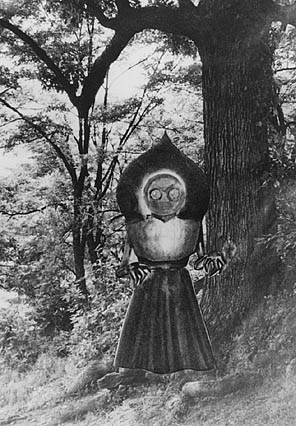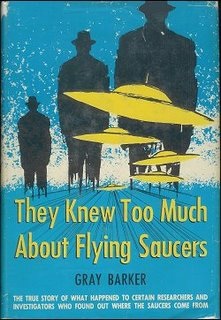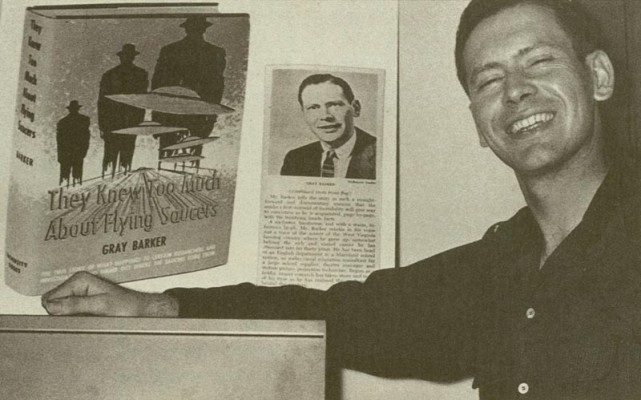By David Halperin
You are David Halperin.
It’s 1960, and you’re twelve going on thirteen, and although you’ve noticed for a while now that there are exciting differences between girls and boys, it’s only recently you’ve begun to grasp that this fact might have some relevance to you. Your mother is sick with heart disease—slowly dying, though no one in your little suburban home dares to talk about that.
You and a friend are doing a project about flying saucers for science class. You go to your local library and check out a book you’ve never heard of, They Knew Too Much About Flying Saucers, by a man named Gray Barker. It looks like any book you might find in your school library. It’s got an index, and even a bibliography, the entries composed the way you’ve been taught bibliography entries ought to be. You take it home and begin reading.
Soon you’re riveted with fear.
You read about a seven-foot monster “worse than Frankenstein,” with glowing green face and red eyes, that landed on a West Virginia hilltop in 1952. You read about a Connecticut man named Albert Bender, who in 1953 solved the flying saucer mystery and was visited by three men in black, who terrified him so he never would reveal the awful secret he’d discovered. You pray God to protect you from all these horrors, seen and unseen; and it never crosses your mind to doubt what you’ve read, partly because it’s written in a LIBRARY BOOK and you trust library books, but also because you know first-hand that life has secrets and shadows so dreadful no one will speak of them. You see them every day, as your mother withers away.
You become a flying saucer investigator, a “UFOlogist,” so you can solve the mystery, not realizing that the real mystery isn’t in the skies but on earth, and it’s spelled not U-F-O but D-E-A-T-H. Or that the really interesting character in They Knew Too Much About Flying Saucersis not the green-faced monster from another planet but a human being named Gray Barker. Who had his own secret. Who had his own terror.
Who knew too much about himself ever to say it out loud.
2.
Gray Roscoe Barker was born in 1925 in Riffle, West Virginia. He lived most of his life in Clarksburg, about fifty miles to the north. He died in 1984 of a disease no one around him understood but which we’ve learned to call AIDS. In these early months of 2012, as we in North Carolina prepare to vote on an amendment to our state constitution banning gay marriage (“Amendment One”), his story is worth some reflection.
In the opening paragraphs of this essay, I’ve tried to imitate the style of his They Knew Too Much, which briefly made the best-seller lists when it came out in 1956. It’s a style breathless and overheated, neither literary nor lofty—but very, very effective.
I never met Barker, either as a teenage UFOlogist nor as the professor of religious studies that I later became. I may have received one letter from him, brief and businesslike; I didn’t keep it, and don’t remember what it was about. In the warm September of 2004, twenty years after Barker’s death, I spent several days in a comfortably furnished, un-air-conditioned room in the Clarksburg-Harrison Public Library browsing through his private papers—now, as the “Barker Collection” open to the public—and feeling myself transported back to the early 1960s. Wondering, over and over: who was this man?
“I am neither a scientist nor a scholar,” he wrote in They Knew Too Much. “Neither am I a bookie, as some people misinterpret my occupation when I tell them I am a booker.” That was how he started: running a film buying-booking agency. And then he discovered flying saucers.
That was his term for them—the neologism “UFO” never much appealed to him. He called himself a “saucerer” or “saucerhunter.” In the late 50s and early 60s he wrote a regular column, “Chasing the Flying Saucers,” for a now-defunct pulp magazine called Flying Saucers.
In the comic drawing that served as the column’s logo, he’s made to look maniacal: racing in pursuit of a flying disk, his tongue hanging out the side of his mouth, camera dangling over his shoulder. A butterfly net waves in his hand. Meanwhile a spaceman, hanging unnoticed from the edge of another disk, reaches out a larger net to grab him.

Photo montage by Gray Barker depicting the legendary Flatwoods Monster. Photograph courtesy of Clarksburg-Harrison Public Library, Gray Barker Collection, date unknown.
Like lots of “saucerers,” he was in it for the money. How could he not be? We religious-studies professors didn’t exactly work on a volunteer basis either; and if during my time at the University of North Carolina I wasn’t quite as concerned with cash flow as Barker was, that was because the taxpayers and student tuitions kept me reliably in grocery money. To stay on the saucers’ trail, Barker had to sing for his supper, typewriter and printing press his instruments. No salaried intellectual has the right to look down on him.
Ah, but did he really believe the stuff he wrote, or the stuff other people wrote and he published (from 1959 on) under his “Saucerian Books” imprint?
To this excellent question I might counter, in Bill-Clinton mode: define “really,” and “believe.” Barker’s mendacity, or let us say freewheeling approach to the truth, is a matter of public record. A former associate, John C. Sherwood, has exposed his modus operandi in a piece tellingly entitled, “Gray Barker: My Friend, the Myth-Maker.” The two films made about him since his death—Ralph Coon’s Whispers from Space (1995), Bob Wilkinson’s brilliant Shades of Gray (2009)—document his merry pranks at the expense of the solemnly credulous. Merry, but slightly squalid. It’s not possible to mock the natural human disposition to trust one another, without acquiring an evil smell.
Barker knew that. He wrote a poem, toward the end of his life I imagine, about the subject that obsessed him and put food on his table:
UFO is a bucket of shit
Its followers: perverts, monomaniacs, dipsomaniacs
Artists of the fast buck
True believers, objective believers, new age believers …
And I sit here writing
While the shit drips down my face
In great rivulets.
In his final book, MIB: The Secret Terror Among Us (MIB=Men in Black), published the year before he died, Barker parodied the ooky-spooky style of They Knew Too Much About Flying Saucers, as if to say: it was all a big joke. And if you took me and my stupid flying saucer book seriously—well, the joke’s on you.
3.
So that was all his “saucers” were to him? An amusement and a meal ticket?
It’s impossible to watch Coon’s film, still less Wilkinson’s, without coming away with some sense of the tragic immensity of the man. A huckster, yes; but something deeper than that. Sherwood had it right: a mythmaker. Understanding myth, à la Carl Jung, to be not a polite synonym for “bunk” but one of the most profound, and profoundly truthful, of our human creations.
He believed, at least initially, in the three men in black. He believed Albert Bender really was silenced in the fall of 1953, and that it was vital for him, and for all of us, to rediscover Bender’s secret. This emerges from his correspondence with his fellow-“saucerer” Morris K. Jessup, which I pored over in the Barker Collection those sweaty September days seven years ago, and which it’s difficult to parse without supposing he genuinely believed Bender had experienced something real and frightening.
He didn’t invent the MIB. But he did give the incident, or the legend—we’re still not wholly sure which it was—the mythic form that allowed it to dive deep into our cultural awareness, emerging on the silver screen, years after Barker’s death, as “Men in Black.” (And “Men in Black 2”; and, coming-soon-to-a-theater-near-you, “Men in Black 3.”) As if his private nightmares spoke to something larger, lurking within the communal unconscious of the society that had wronged him, forced him to its margins.
As they spoke to me.
I didn’t know much when I was twelve going on thirteen. For me, as I suppose for most people back then, “gay” just meant “happy,” “cheerful.” But I knew intuitively that Barker’s bizarre, fantastic, wildly implausible book spoke the truth.
He did have a secret, and it was dreadful—not in any absolute sense, but in relation to his time and place, mid-twentieth-century West Virginia. Had his sexual orientation come to light, his life would have been blown into bloody fragments, and he knew it. Would it be that way today? Maybe not; we’ve come a long way toward respecting the human yearning to love, whatever form it takes. But the presence of a homophobic constitutional amendment on the North Carolina ballot this coming May shows we’ve got a ways to go, before Barker’s tormented spirit can rest in peace.
When he wrote about Bender, he wrote about himself. The Men in Black, with their hush-up threats and their terror, hovered over Gray Barker each day of his grownup life. That was what gave They Knew Too Much About Flying Saucers its tremendous emotional authenticity, calling out to a boy obliged to bear a different secret.
My mother was doomed. Barker also was doomed, to a death even lonelier than hers. At least her death wasn’t hurried along by prejudice, by socially enforced silence. May the Barkers of the next generation be able to say the same.
David Halperin is Professor Emeritus of Religious Studies, University of North Carolina at Chapel Hill. His novel Journal of a UFO Investigator was published last year by Viking Press. It’s appeared in Spanish translation; Italian and German editions are forthcoming. David blogs about UFOs, religion, and related subjects at www.davidhalperin.net.
Many of Gray Barker’s “Chasing the Flying Saucers” columns have been republished in recent years, and are available from Rick Hilberg, 377 Race St., Berea, OH 44017.
My warmest thanks to David Houchin, curator of the Barker Collection, for his hospitality and assistance on my visit to Clarksburg in 2004.


